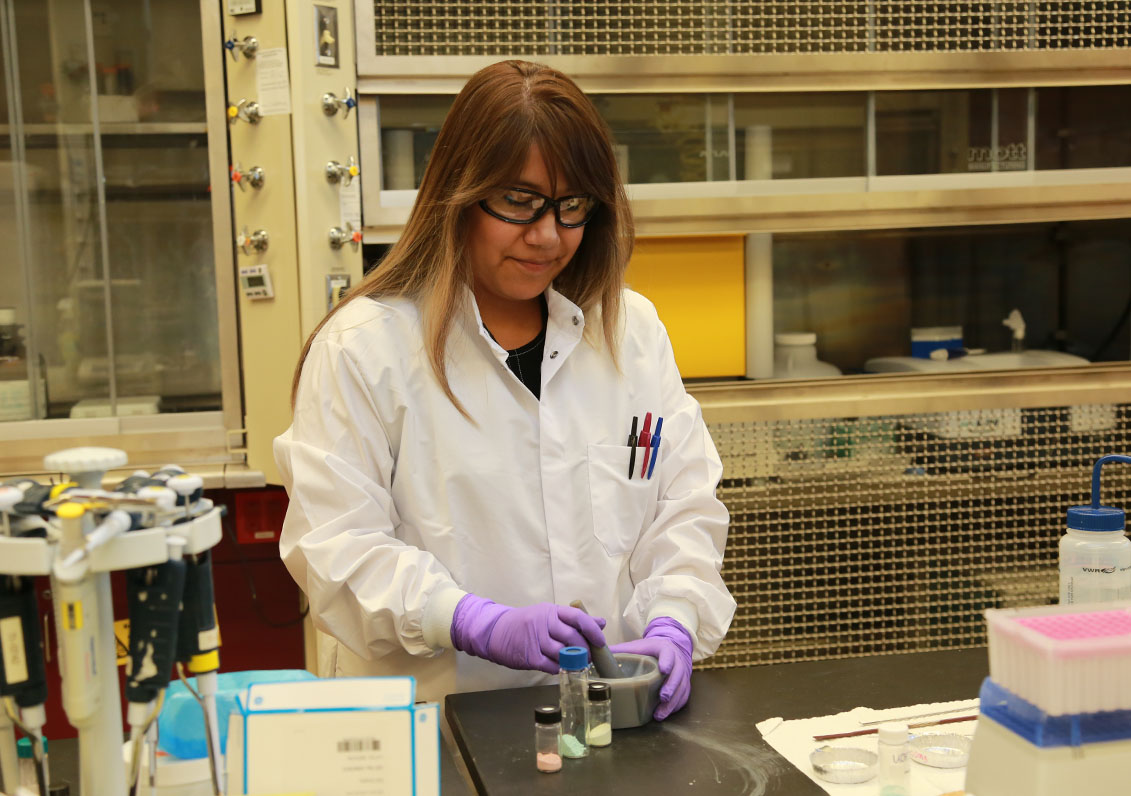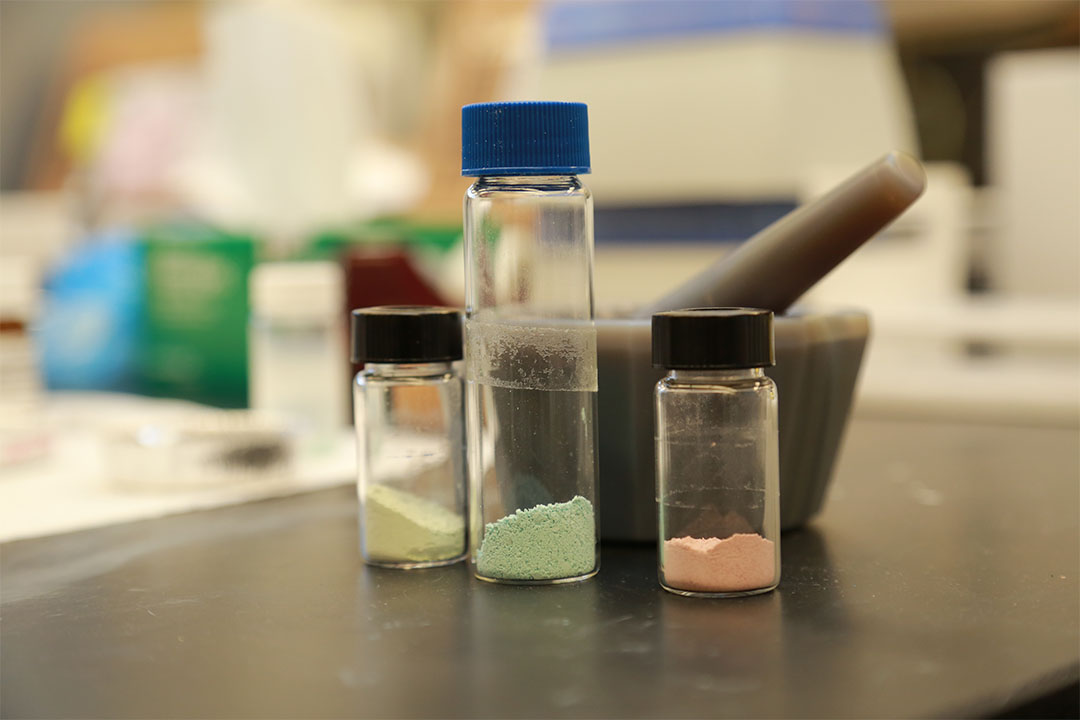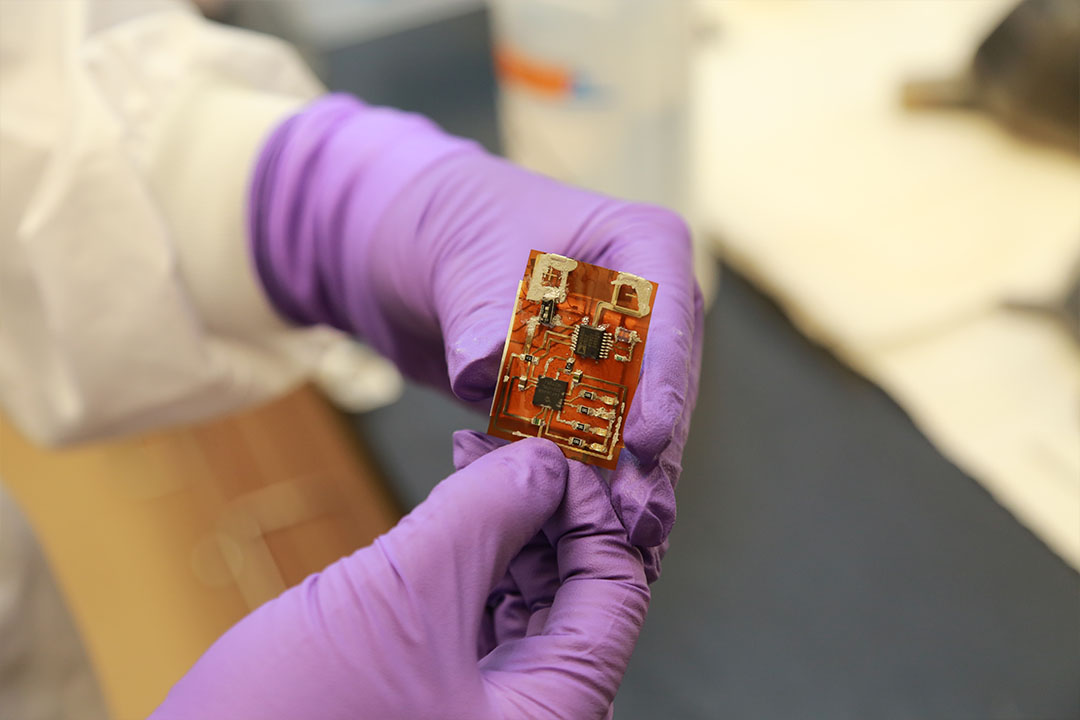// NEWS RELEASE
New Color Changing Materials Discovered for Chemical Threat Detection
Rapid color changes mean increased awareness for CBRNE Soldiers
CCDC Chemical Biological Center Public Affairs | March 27th, 2019
New Color Changing Materials Discovered for Chemical Threat Detection
Rapid color changes mean increased awareness for CBRNE Soldiers
DEVCOM CBC Public AffairsMarch 27th, 2019

Jennifer Soliz, Ph.D., pulverizes self-indicating colormetric response materials with a mortar and pestle. (Photo Credit: CCDC Chemical Biological Center photo by Shawn Nesaw)
A plume of unidentified smoke fills the air ahead of ground units on the battlefield. Immediately, a gray drone deploys, navigating the atmosphere to investigate the plume. As the drone returns, it’s no longer gray. It’s orange. That color change is due to a new coating on the drone that, when exposed to a chemical agent, instantly changes colors alerting warfighters to a threat compound.
The notional scenario above illustrates the potential of colorimetric detection. As Soldiers come in contact with potential toxic chemical threats in the field, they need to know what they are dealing with so they can take the proper action. Based on the needs of Soldiers, scientists are developing new methods of chemical threat detection to keep Soldiers safe.
One of the newest breakthroughs in colorimetric detection is the development of self-indicating colorimetric response materials, inorganic compounds that selectively detect chemical agents and opioids through chemical reactions when exposed to specific compounds, prompting an immediate color change.
Besides rapid and vivid color changes, these materials can detect chemical threats in different physical phases as well as various contaminated surfaces, including contaminated concrete and asphalt. Additionally, once the materials change color, that color change is irreversible, another first.
The current standard for chemical threat detection using color change is M8 paper. Similar to pH paper used in high school or college chemistry courses, the M8 paper changes colors when exposed, indicating the identity of the chemical tested.
Synthesizing a detection material that selectively changes color with the analyte (in all physical phases) and stays that way over time was a main goal for U.S. Army Combat Capabilities Development Command (CCDC) Chemical Biological Center research scientist Jennifer Soliz, Ph.D.
“Self-indicating colorimetric response materials maintain their color change once exposed, which is one of the primary benefits of these novel materials,” Dr. Soliz said. She discovered the materials and is leading the effort to further develop them.

“I have synthesized several inorganic compositions of the self-indicating colorimetric response materials over time and have had them tested and evaluated with agents, opioids, and interferents,” explained Dr. Soliz. “It was exciting to receive news that exposing the materials to specific analytes produced the expected color changes and that the materials did not change color when exposed to interferents, which was a significant breakthrough for the Army.”
The irreversible selective color changing properties of self-indicating colorimetric response materials makes them valuable for the warfighter’s survival. For instance, when a vehicle exposed to a threat returns to a location, the color change of the vehicle’s surface coating will be unmistakable, indicating its need for decontamination.
Self-indicating colorimetric response materials expand the Army’s capability to accurately detect different physical states of chemical threats. Off-gassing, where the chemical threat has absorbed into concrete or some other porous medium, poses an invisible hazard to the warfighter. While current colorimetric detection tools require the use of solvents for detection or are limited to neat solutions of agents, self-indicating colorimetric response materials can detect a wide range of concentrations of vapor hazards without the need for solvent.
Each self-indicating colorimetric response material is designed to selectively detect a different class of chemical agents, such as G-type compounds (e.g. sarin), V-type compounds (e.g. RVX), and H-type compounds (e.g. sulfur mustard), by changing to a different color. They are also able to detect opioids as well as other emerging threat compounds.

The Defense Threat Reduction Agency has provided funding for this research project for the past year. Dr. Soliz has a few patent applications pending on the self-indicating colorimetric response materials and is planning to expand this effort.
The materials are currently being developed into films, coatings, and ultra-lightweight portable chemical sensors. Dr. Soliz is also collaborating with physicists and engineers at the University of Alabama to develop and incorporate the materials into chemical sensing prototypes. Applications include incorporating them into fiber optic cables for perimeter defense security and equipment coatings for unmanned Army operations.
As the U.S. Army continues its modernization efforts through priorities such as developing the next-generation combat vehicle, CCDC Chemical Biological Center scientists continue to research and develop new materials to protect the warfighter from unseen chemical threats.
The U.S. Army Combat Capabilities Development Command (DEVCOM) leads in the discovery, development and delivery of technology-based capabilities to enable Soldiers to win our nation’s wars and come home safely. DEVCOM is a major subordinate command of the U.S. Army Futures Command. The DEVCOM Chemical Biological Center is the Army’s principal research and development center for chemical and biological defense technology, engineering and field operations. The DEVCOM Chemical Biological Center is headquartered at Aberdeen Proving Ground, Maryland.
